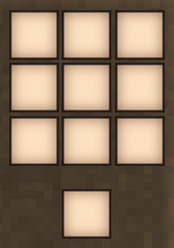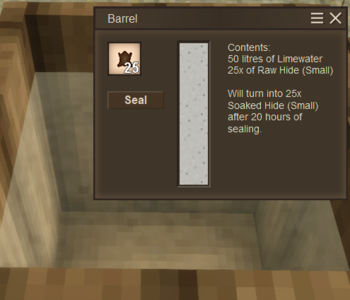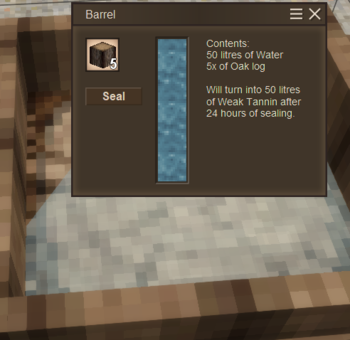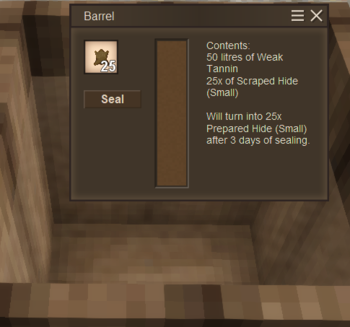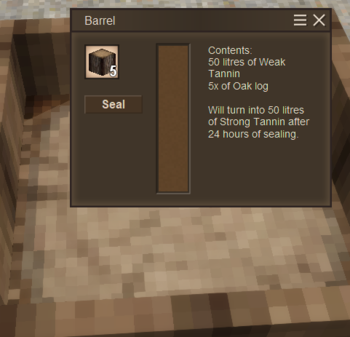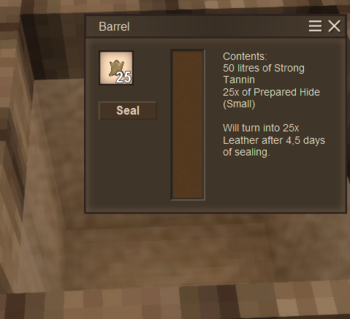Leather working/de: Difference between revisions
No edit summary |
Luntenberg (talk | contribs) (Created page with "Kalk") |
||
| (26 intermediate revisions by 2 users not shown) | |||
| Line 1: | Line 1: | ||
<languages/> | <languages/><br> | ||
'''Lederverarbeitung''' ist eine spezialisierte Serie von [[barrel|Fass]]-Rezepten, mit denen Spieler rohe Häute in [[leather|Leder]] umwandeln können. | |||
__TOC__ | |||
===Benötigte Materialien==== | |||
Um Leder herzustellen, benötigt ein Spieler: | |||
* ein Vorrat an {{ll|lime|Kalk}} oder {{ll|Borax|Pulverisiertes Borax}}. | |||
* ein Vorrat an {{ll|Log|Eichen-}} oder {{ll|Log|Akazien}}stämmen, um Tannine – pflanzliche Gerbstoffe – herzustellen. | |||
* ein {{ll|Wooden Bucket|Eimer}} oder eine Tonschale um Flüssigkeiten zu transportieren. Ein Eimer kann zehn Liter Flüssigkeit halten und eine Schüssel einen Liter. | |||
* {{ll|Barrel|Fässer}}, um die Häute zu verarbeiten. Ein Fass kann 50 Liter an Flüssigkeit aufnehmen. | |||
* unbehandelte Häute. | |||
* ein {{ll|knife|Messer}}. | |||
* einen {{ll|hammer|Hammer}} oder eine {{ll|quern|Handmühle}}. | |||
===Häute=== | |||
Häute können von sowohl wilden, toten als auch domestizierten, toten Tieren erhalten werden. Die folgenden Tiere haben die Chance eine Haut fallenzulassen: | |||
* Kleine Häute: {{ll|Hare|Hase}}, {{ll|Raccoon|Waschbär}}, {{ll|Fox|Fuchs}}, {{ll|Sheep|Lamm}} | |||
* Mittlere Häute: {{ll|Wild Pig|Wildschwein}}, {{ll|Hyena|Hyäne}}, {{ll|Wolf|Wolf}} | |||
* Große Häute: {{ll|Bighorn sheep|Dickhornschaf}}, {{ll|Gazelle|Gazelle}} | |||
* Riesige Häute: {{ll|Bear|Bär}} | |||
===Kalk & Pulverisierter Borax=== | |||
Kalk kann aus losem {{ll|limestone|Kalkstein}}, {{ll|chalk|Kreidestein}}, oder Meermuscheln gewonnen werden. Kalkstein und Kreide können mit Hilfe eines {{ll|hammer|Hammers}} in deinem Herstellungsfeld zerschlagen, oder in einer {{ll|quern|Handmühle}} zermahlen, werden. Beide Methoden liefern die gleiche Menge an Kalk pro Stein; obwohl das Benutzen eines Hammers auch einen Teil der Haltbarkeit verbraucht, wohingegen die Handmühle keinen Schaden durch Benutzung nimmt. Ein Stein liefert einen Kalk. | |||
Eine Muschel liefert zwei Kalk und können nur in einer Handmühle verarbeitet werden – ein Hammer ist dafür unzulänglich. | |||
Kalk kann zur Herstellung von gebranntem Kalk benutzt werden, welcher zur Produktion von {{ll|plaster|Putz}} und {{ll|mortar|Mörtel}} benötigt wird. | |||
Pulverisierter Borax ist eine Alternative zu Kalk die durch das Zermahlen von einem Stück {{ll|borax|Boraxerz}} in einer {{ll|quern|Handmühle}} gewonnen wird. Ein Stück Borax liefert zwei pulverisierten Borax.<br> | |||
Pulverisierter Borax wird auch für das Schmieden von Eisen- oder Meteoriteneisen{{ll|anvil|ambossen}} benötigt. | |||
{{Crafting | |||
|Ingredients= 1x {{ll|Hammer|Hammer}}<br>3x {{ll|Stone|Kalkstein}} | |||
|Grid/CraftingCode={{Grid/Crafting | |||
|B2=Copper hammer|B2-link=Special:MyLanguage/Hammer|B2_name=Hammer | |||
|B3=Chalk stone|B3-link=Special:MyLanguage/Stone|B3_name=Kalkstein | |||
|Output=Lime|Output_name=Kalk | |||
}}}} | |||
<div lang="en" dir="ltr" class="mw-content-ltr"> | |||
=== Example Shopping List=== | |||
</div> | |||
<div lang="en" dir="ltr" class="mw-content-ltr"> | |||
To process 8 leather, which would be sufficient to craft 1 {{ll|backpack|leather backpack}}, the player would need the following materials (rounded up in parentheses): | |||
</div> | |||
<div lang="en" dir="ltr" class="mw-content-ltr"> | |||
*Oak or Acacia Logs: 3 for small hides or 6 for medium, large or huge hides | |||
*Lime or Powdered Borax - one lime or chalk stone can be ground into one lime; one borax can be ground into two powdered borax | |||
**Lime: 8 for small, 17 (20) for medium, 19 (20) L for large and 20 L for huge | |||
**Powdered borax: 4 for small or 8 for medium, large or huge | |||
*Hides: either 8 small, 4 medium, 3 large or 2 huge | |||
*Limewater or Diluted Borax: 8 (10) L for small, 17 (20) L for medium, 19 (20) L for large and 20 L for huge | |||
*Weak Tannin: 16 (20) L for small, 34 (40) L for medium, 38 (40) L for large and 40 L for huge - of which half will be turned into: | |||
*Strong tannin: 8 (10) L for small, 17 (20) L for medium, 19 (20) L for large and 20 L for huge | |||
</div> | |||
<div lang="en" dir="ltr" class="mw-content-ltr"> | |||
== Hide Processing Sequence == | |||
</div> | |||
<div lang="en" dir="ltr" class="mw-content-ltr"> | |||
Players may only process one size of hide at a time: small, medium, large, or huge. Also, each of the sizes use different amounts of solution. One huge, large, medium or small hide require 10, 6, 4, or 2 liters respectively. | |||
</div> | |||
<div lang="en" dir="ltr" class="mw-content-ltr"> | |||
The different sizes of hides also give different amounts of leather after finished processing. One huge, large, medium, and small hide produce 5, 3, 2, and 1 leather respectively. | |||
</div> | |||
<div lang="en" dir="ltr" class="mw-content-ltr"> | |||
The following chart shows the requirements to make one full barrel of each solution, as used farther down in the respective processing steps: | |||
</div> | |||
{| class="wikitable" | |||
! <span lang="en" dir="ltr" class="mw-content-ltr">Base Liquid</span> | |||
! <span lang="en" dir="ltr" class="mw-content-ltr">Solvent</span> | |||
! <span lang="en" dir="ltr" class="mw-content-ltr">Makes 1 Full Barrel of</span> | |||
|- | |||
|50 L <span lang="en" dir="ltr" class="mw-content-ltr">Water</span> ||50 <span lang="en" dir="ltr" class="mw-content-ltr">Lime</span> || <span lang="en" dir="ltr" class="mw-content-ltr">Limewater</span> | |||
|- | |||
|50 L <span lang="en" dir="ltr" class="mw-content-ltr">Water</span> ||20 <span lang="en" dir="ltr" class="mw-content-ltr">powdered borax</span> || <span lang="en" dir="ltr" class="mw-content-ltr">Diluted Borax</span> | |||
|- | |||
|50 L <span lang="en" dir="ltr" class="mw-content-ltr">Water</span> ||5 <span lang="en" dir="ltr" class="mw-content-ltr">oak/acacia logs</span>|| <span lang="en" dir="ltr" class="mw-content-ltr">Weak Tannin</span> | |||
|- | |||
|50 L <span lang="en" dir="ltr" class="mw-content-ltr">Weak Tannin</span> ||5 <span lang="en" dir="ltr" class="mw-content-ltr">oak/acacia logs</span> || <span lang="en" dir="ltr" class="mw-content-ltr">Strong Tannin</span> | |||
|} | |||
<div lang="en" dir="ltr" class="mw-content-ltr"> | |||
=== Step 1: Limewater or Diluted Borax === | |||
</div> | |||
<div lang="en" dir="ltr" class="mw-content-ltr"> | |||
To make soaked hides, limewater or diluted borax may be used: | |||
* Limewater: 1 liter of water and 1 lime makes 1 liter of limewater - which means a full barrel of limewater requires 50 lime. | |||
* Diluted borax: 5 liters of water and 2 powdered borax make 5 liters of diluted borax - which means a full barrel of diluted borax requires 20 powdered borax. | |||
</div> | |||
<div lang="en" dir="ltr" class="mw-content-ltr"> | |||
To make either limewater or diluted borax, it is not required to seal the barrel or wait for a processing time. Simply add the required amount of lime or powdered borax to a barrel filled with the required amount of water; if the ratio is correct, the water will instantly change into limewater or diluted borax. If the player is unsure about the correct ratio, simply fill the barrel with the amount of water and keep adding lime or powdered borax one by one until the change happens. | |||
</div> | |||
<div lang="en" dir="ltr" class="mw-content-ltr"> | |||
Once the player has acquired the necessary lime or borax solution, the raw hides can be placed inside the barrel, after which it needs to be sealed for 20 in-game hours to turn into soaked hides. Similar to the above process, a specific ratio must be reached. The player can start with one hide and check the barrel tooltip; it should display the amount of liquid solution and input hides as well as the possible output. If there is no output shown, the player placed too many hides in the barrel for the available amount of liquid. | |||
</div> | |||
<div lang="en" dir="ltr" class="mw-content-ltr"> | |||
<gallery widths=350px heights=350px mode="none"> | |||
File:Leather Lime.PNG|The maximum amount of small hides in one barrel of limewater. | |||
</gallery> | |||
</div> | |||
<div lang="en" dir="ltr" class="mw-content-ltr"> | |||
=== Step 2: Scraping Hides === | |||
</div> | |||
<div lang="en" dir="ltr" class="mw-content-ltr"> | |||
Once the raw hides have been soaked long enough, they will turn into soaked hides. These cannot directly be further processed in barrels; another crafting step comes in between. The player needs to put the soaked hides and a knife into the inventory crafting grid to process them into scraped hides. Please note that the knife will lose durability in the process. | |||
</div> | |||
=== | {{Crafting | ||
|Ingredients= 1x {{ll|Knife|<span lang="en" dir="ltr" class="mw-content-ltr">Knife</span>}}<br>1x {{ll|Leather working|<span lang="en" dir="ltr" class="mw-content-ltr">Soaked hide</span>}} | |||
|Grid/CraftingCode={{Grid/Crafting | |||
|B2=Copper knife|B2-link=Special:MyLanguage/Knife|B2_name=<span lang="en" dir="ltr" class="mw-content-ltr">Knife</span> | |||
|B3=Hide soaked|B3-link=Special:MyLanguage/Leather working|B3_name=<span lang="en" dir="ltr" class="mw-content-ltr">Soaked hide</span> | |||
|Output=Hide scraped|Output_name=<span lang="en" dir="ltr" class="mw-content-ltr">Scraped hide</span> | |||
}}}} | |||
<div lang="en" dir="ltr" class="mw-content-ltr"> | |||
=== Step 3: Weak Tannin === | |||
</div> | |||
<div lang="en" dir="ltr" class="mw-content-ltr"> | |||
To make weak tannin, the player needs 10 units of water per oak/acacia log. After inputting the oak log, the barrel tooltip will display the materials present as well as the predicted output. The barrel must be sealed for 24 in-game hours to actually produce weak tannin; it cannot be sealed if an unbalanced ratio of water and oak logs are present in the barrel. | |||
</div> | |||
<div lang="en" dir="ltr" class="mw-content-ltr"> | |||
After the player acquired weak tannin with the above procedure, place the scraped hides into the weak tannin solution. Again, further processing of the hides requires sealing in the barrel - after 4 in-game days they will become prepared hides. Similar to the previous processes, a specific ratio must be reached. The player can start with one hide and check the barrel tool tip; it should display the possible output. If there is no output shown, the player placed too many hides in the barrel for the available amount of liquid, and the player will not be able to seal it. | |||
</div> | |||
<div lang="en" dir="ltr" class="mw-content-ltr"> | |||
<gallery widths=350px heights=350px mode="none"> | |||
File:Weak tannin.PNG|Weak tannin can be created from water and oak logs. | |||
File:Leather weak tannin.PNG|The maximum amount of small scraped hides in one barrel of weak tannin. | |||
</gallery> | |||
</div> | |||
<div lang="en" dir="ltr" class="mw-content-ltr"> | |||
=== Step 4: Strong Tannin === | |||
</div> | |||
<div lang="en" dir="ltr" class="mw-content-ltr"> | |||
To make strong tannin, the player needs 10 liters of weak tannin per oak/acacia log. After inputting the log, the barrel tooltip will display the materials present as well as the predicted output. The barrel must be sealed for 24 in-game hours to actually produce strong tannin; it cannot be sealed if an unbalanced ratio of water and oak logs are present in the barrel. | |||
</div> | |||
<div lang="en" dir="ltr" class="mw-content-ltr"> | |||
After the player acquired strong tannin with the above procedure, place the prepared hides into the strong tannin solution. Again, further processing of the hides requires sealing in the barrel; after another 4.5 in-game days they will become leather. Similar to the previous processes, a specific ratio must be reached. The player can start with one hide and check the barrel tooltip; it should display the possible output. If there is no output shown, the player placed too many hides in the barrel for the available amount of liquid, and the player will not be able to seal it. | |||
</div> | |||
<div lang="en" dir="ltr" class="mw-content-ltr"> | |||
After waiting for the sealed hides to process, the player will be rewarded with the respective amount of {{ll|leather|leather}} ready to be used in crafting. | |||
</div> | |||
<div lang="en" dir="ltr" class="mw-content-ltr"> | |||
<gallery widths=350px heights=350px mode="none"> | |||
File:Strong tannin.PNG|Strong tannin can be created from weak tannin and oak or acacia logs. | |||
File:Leather strong tannin.PNG|The maximum amount of small prepared hides in one barrel of strong tannin. | |||
</gallery> | |||
</div> | |||
<div lang="en" dir="ltr" class="mw-content-ltr"> | |||
==Pelt== | |||
</div> | |||
<div lang="en" dir="ltr" class="mw-content-ltr"> | |||
Different from Leather, making pelts is relatively easy. | |||
</div> | |||
<div lang="en" dir="ltr" class="mw-content-ltr"> | |||
===Hide curing=== | |||
</div> | |||
<div lang="en" dir="ltr" class="mw-content-ltr"> | |||
To create pelts, only two steps need to be followed. First, raw hides need to be oiled. This can be done by combining raw hide and {{ll|fat|fat}} in the crafting grid using the following ratio: 4 small hide + 1 fat, 2 medium hide + 1 fat, 1 large hide + 1 fat or 1 huge hide + 2 fats. | |||
</div> | |||
| | |||
=== | {{Crafting | ||
|Ingredients= 1x {{ll|Fat|<span lang="en" dir="ltr" class="mw-content-ltr">Fat</span>}}<br>1x {{ll|Leather working|<span lang="en" dir="ltr" class="mw-content-ltr">Raw hide</span>}} | |||
|Grid/CraftingCode={{Grid/Crafting | |||
|A1=Fat|A1-link=Special:MyLanguage/Fat|A1_name=<span lang="en" dir="ltr" class="mw-content-ltr">Fat</span> | |||
|A2=Raw hide|A2-link=Special:MyLanguage/Leather working|A2_name=<span lang="en" dir="ltr" class="mw-content-ltr">Raw hide</span> | |||
|Output=Hide oiled|Output_name=<span lang="en" dir="ltr" class="mw-content-ltr">Oiled hide</span> | |||
}}}} | |||
<div lang="en" dir="ltr" class="mw-content-ltr"> | |||
In a second step, these oiled hides need to be "cured", which means nothing else but leaving them untouched for 48 hours. There is no process involved and the storage place doesn't matter - the player can carry them around in the inventory or leave them in a storage container. The tooltip on the item will inform how much the curing has progressed. | |||
Once completely cured, the oiled hides will turn into pelts that can be used in different crafting recipes. | |||
</div> | |||
<div lang="en" dir="ltr" class="mw-content-ltr"> | |||
===Usage=== | |||
</div> | |||
=== | <div lang="en" dir="ltr" class="mw-content-ltr"> | ||
Medium or large pelts are required to craft the {{ll|hunter's backpack|hunter's backpack}}, a cheaper variant of the leather backpack with only 4 slots, as well as the Lamellar armor recipes and fur clothing recipes. Small or medium pelts are required for the {{ll|longbow|longbow}} recipe. | |||
</div> | |||
{{Crafting | |||
|Ingredients= 15x {{ll|Reed|<span lang="en" dir="ltr" class="mw-content-ltr">Cattails</span>}}<br>1x {{ll|Leather working|<span lang="en" dir="ltr" class="mw-content-ltr">Pelt (Large)</span>}} | |||
|Grid/CraftingCode={{Grid/Crafting | |||
|A1=Cattail tops|A1N=3|A1-link=Reed|A1_name=<span lang="en" dir="ltr" class="mw-content-ltr">Cattails</span> | |||
|B1=hide pelt large|B1-link=Special:MyLanguage/Leather working|B1_name=<span lang="en" dir="ltr" class="mw-content-ltr">Pelt (Large)</span> | |||
|C1=Cattail tops|C1N=3|C1-link=Reed|C1_name=<span lang="en" dir="ltr" class="mw-content-ltr">Cattails</span> | |||
|A2=Cattail tops|A2N=3|A2-link=Reed|A2_name=<span lang="en" dir="ltr" class="mw-content-ltr">Cattails</span> | |||
|B2=Cattail tops|B2N=3|B2-link=Reed|B2_name=<span lang="en" dir="ltr" class="mw-content-ltr">Cattails</span> | |||
|C2=Cattail tops|C2N=3|C2-link=Reed|C2_name=<span lang="en" dir="ltr" class="mw-content-ltr">Cattails</span> | |||
|Output=hunterbackpack|Output_name=<span lang="en" dir="ltr" class="mw-content-ltr">Hunter's backpack</span> | |||
}}}} | |||
<div lang="en" dir="ltr" class="mw-content-ltr"> | |||
== Video Tutorials == | |||
</div> | |||
{| class="wikitable" | |||
< | |- | ||
<youtube> | ! <span lang="en" dir="ltr" class="mw-content-ltr">Detailed explanation how to make leather.</span> | ||
|- | |||
| <youtube width="400" height="240">4nmbH1G2lts</youtube> | |||
|} | |||
{{ | {{Game navbox}} | ||
[[Category:Guides{{#translation:}}]] | |||
Latest revision as of 20:06, 15 August 2023
Lederverarbeitung ist eine spezialisierte Serie von Fass-Rezepten, mit denen Spieler rohe Häute in Leder umwandeln können.
Benötigte Materialien=
Um Leder herzustellen, benötigt ein Spieler:
- ein Vorrat an Kalk oder Pulverisiertes Borax.
- ein Vorrat an Eichen- oder Akazienstämmen, um Tannine – pflanzliche Gerbstoffe – herzustellen.
- ein Eimer oder eine Tonschale um Flüssigkeiten zu transportieren. Ein Eimer kann zehn Liter Flüssigkeit halten und eine Schüssel einen Liter.
- Fässer, um die Häute zu verarbeiten. Ein Fass kann 50 Liter an Flüssigkeit aufnehmen.
- unbehandelte Häute.
- ein Messer.
- einen Hammer oder eine Handmühle.
Häute
Häute können von sowohl wilden, toten als auch domestizierten, toten Tieren erhalten werden. Die folgenden Tiere haben die Chance eine Haut fallenzulassen:
- Kleine Häute: Hase, Waschbär, Fuchs, Lamm
- Mittlere Häute: Wildschwein, Hyäne, Wolf
- Große Häute: Dickhornschaf, Gazelle
- Riesige Häute: Bär
Kalk & Pulverisierter Borax
Kalk kann aus losem Kalkstein, Kreidestein, oder Meermuscheln gewonnen werden. Kalkstein und Kreide können mit Hilfe eines Hammers in deinem Herstellungsfeld zerschlagen, oder in einer Handmühle zermahlen, werden. Beide Methoden liefern die gleiche Menge an Kalk pro Stein; obwohl das Benutzen eines Hammers auch einen Teil der Haltbarkeit verbraucht, wohingegen die Handmühle keinen Schaden durch Benutzung nimmt. Ein Stein liefert einen Kalk.
Eine Muschel liefert zwei Kalk und können nur in einer Handmühle verarbeitet werden – ein Hammer ist dafür unzulänglich.
Kalk kann zur Herstellung von gebranntem Kalk benutzt werden, welcher zur Produktion von Putz und Mörtel benötigt wird.
Pulverisierter Borax ist eine Alternative zu Kalk die durch das Zermahlen von einem Stück Boraxerz in einer Handmühle gewonnen wird. Ein Stück Borax liefert zwei pulverisierten Borax.
Pulverisierter Borax wird auch für das Schmieden von Eisen- oder Meteoriteneisenambossen benötigt.
| Ingredients | Crafting Recipe |
|---|---|
| 1x Hammer 3x Kalkstein |
Example Shopping List
To process 8 leather, which would be sufficient to craft 1 leather backpack, the player would need the following materials (rounded up in parentheses):
- Oak or Acacia Logs: 3 for small hides or 6 for medium, large or huge hides
- Lime or Powdered Borax - one lime or chalk stone can be ground into one lime; one borax can be ground into two powdered borax
- Lime: 8 for small, 17 (20) for medium, 19 (20) L for large and 20 L for huge
- Powdered borax: 4 for small or 8 for medium, large or huge
- Hides: either 8 small, 4 medium, 3 large or 2 huge
- Limewater or Diluted Borax: 8 (10) L for small, 17 (20) L for medium, 19 (20) L for large and 20 L for huge
- Weak Tannin: 16 (20) L for small, 34 (40) L for medium, 38 (40) L for large and 40 L for huge - of which half will be turned into:
- Strong tannin: 8 (10) L for small, 17 (20) L for medium, 19 (20) L for large and 20 L for huge
Hide Processing Sequence
Players may only process one size of hide at a time: small, medium, large, or huge. Also, each of the sizes use different amounts of solution. One huge, large, medium or small hide require 10, 6, 4, or 2 liters respectively.
The different sizes of hides also give different amounts of leather after finished processing. One huge, large, medium, and small hide produce 5, 3, 2, and 1 leather respectively.
The following chart shows the requirements to make one full barrel of each solution, as used farther down in the respective processing steps:
| Base Liquid | Solvent | Makes 1 Full Barrel of |
|---|---|---|
| 50 L Water | 50 Lime | Limewater |
| 50 L Water | 20 powdered borax | Diluted Borax |
| 50 L Water | 5 oak/acacia logs | Weak Tannin |
| 50 L Weak Tannin | 5 oak/acacia logs | Strong Tannin |
Step 1: Limewater or Diluted Borax
To make soaked hides, limewater or diluted borax may be used:
- Limewater: 1 liter of water and 1 lime makes 1 liter of limewater - which means a full barrel of limewater requires 50 lime.
- Diluted borax: 5 liters of water and 2 powdered borax make 5 liters of diluted borax - which means a full barrel of diluted borax requires 20 powdered borax.
To make either limewater or diluted borax, it is not required to seal the barrel or wait for a processing time. Simply add the required amount of lime or powdered borax to a barrel filled with the required amount of water; if the ratio is correct, the water will instantly change into limewater or diluted borax. If the player is unsure about the correct ratio, simply fill the barrel with the amount of water and keep adding lime or powdered borax one by one until the change happens.
Once the player has acquired the necessary lime or borax solution, the raw hides can be placed inside the barrel, after which it needs to be sealed for 20 in-game hours to turn into soaked hides. Similar to the above process, a specific ratio must be reached. The player can start with one hide and check the barrel tooltip; it should display the amount of liquid solution and input hides as well as the possible output. If there is no output shown, the player placed too many hides in the barrel for the available amount of liquid.
Step 2: Scraping Hides
Once the raw hides have been soaked long enough, they will turn into soaked hides. These cannot directly be further processed in barrels; another crafting step comes in between. The player needs to put the soaked hides and a knife into the inventory crafting grid to process them into scraped hides. Please note that the knife will lose durability in the process.
| Ingredients | Crafting Recipe |
|---|---|
| 1x Knife 1x Lederverarbeitung |
Step 3: Weak Tannin
To make weak tannin, the player needs 10 units of water per oak/acacia log. After inputting the oak log, the barrel tooltip will display the materials present as well as the predicted output. The barrel must be sealed for 24 in-game hours to actually produce weak tannin; it cannot be sealed if an unbalanced ratio of water and oak logs are present in the barrel.
After the player acquired weak tannin with the above procedure, place the scraped hides into the weak tannin solution. Again, further processing of the hides requires sealing in the barrel - after 4 in-game days they will become prepared hides. Similar to the previous processes, a specific ratio must be reached. The player can start with one hide and check the barrel tool tip; it should display the possible output. If there is no output shown, the player placed too many hides in the barrel for the available amount of liquid, and the player will not be able to seal it.
Step 4: Strong Tannin
To make strong tannin, the player needs 10 liters of weak tannin per oak/acacia log. After inputting the log, the barrel tooltip will display the materials present as well as the predicted output. The barrel must be sealed for 24 in-game hours to actually produce strong tannin; it cannot be sealed if an unbalanced ratio of water and oak logs are present in the barrel.
After the player acquired strong tannin with the above procedure, place the prepared hides into the strong tannin solution. Again, further processing of the hides requires sealing in the barrel; after another 4.5 in-game days they will become leather. Similar to the previous processes, a specific ratio must be reached. The player can start with one hide and check the barrel tooltip; it should display the possible output. If there is no output shown, the player placed too many hides in the barrel for the available amount of liquid, and the player will not be able to seal it.
After waiting for the sealed hides to process, the player will be rewarded with the respective amount of leather ready to be used in crafting.
Pelt
Different from Leather, making pelts is relatively easy.
Hide curing
To create pelts, only two steps need to be followed. First, raw hides need to be oiled. This can be done by combining raw hide and fat in the crafting grid using the following ratio: 4 small hide + 1 fat, 2 medium hide + 1 fat, 1 large hide + 1 fat or 1 huge hide + 2 fats.
| Ingredients | Crafting Recipe |
|---|---|
| 1x Fat 1x Lederverarbeitung |
In a second step, these oiled hides need to be "cured", which means nothing else but leaving them untouched for 48 hours. There is no process involved and the storage place doesn't matter - the player can carry them around in the inventory or leave them in a storage container. The tooltip on the item will inform how much the curing has progressed. Once completely cured, the oiled hides will turn into pelts that can be used in different crafting recipes.
Usage
Medium or large pelts are required to craft the hunter's backpack, a cheaper variant of the leather backpack with only 4 slots, as well as the Lamellar armor recipes and fur clothing recipes. Small or medium pelts are required for the longbow recipe.
| Ingredients | Crafting Recipe |
|---|---|
| 15x Reed 1x Lederverarbeitung |
Video Tutorials
| Detailed explanation how to make leather. |
|---|
| Wiki Navigation | |
|---|---|
| Vintage Story | Guides • Frequently Asked Questions • Soundtrack • Versions • Controls |
| Game systems | Crafting • Knapping • Clay forming • Smithing • Cooking • Temperature • Hunger • Mining • Temporal stability • Mechanical power • Trading • Farming • Animal husbandry |
| World | World generation • Biomes • Weather • Temporal storms |
| Items | Tools • Weapons • Armor • Clothing • Bags • Materials • Food |
| Blocks | Terrain • Plants • Decorative • Lighting • Functional • Ore |
| Entities | Hostile entities • Animals • NPCs • Players |
| Miscellaneous | List of client commands • List of server commands • Creative Starter Guide • Bot System • WorldEdit • Cinematic Camera • Adjustable FPS Video Recording • ServerBlockTicking |
